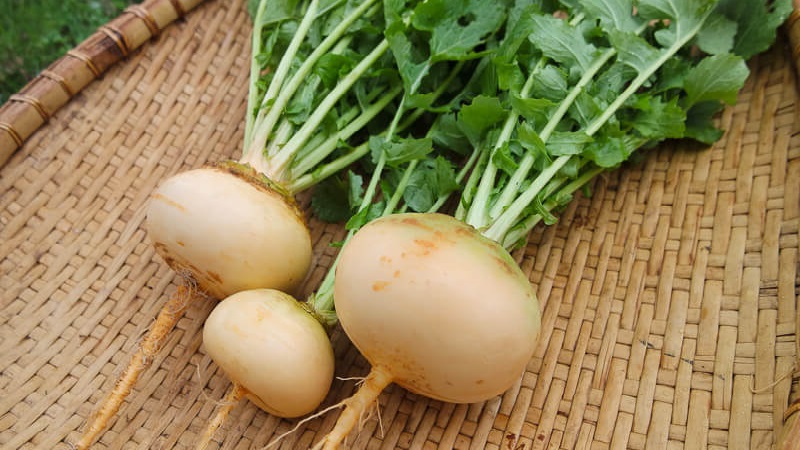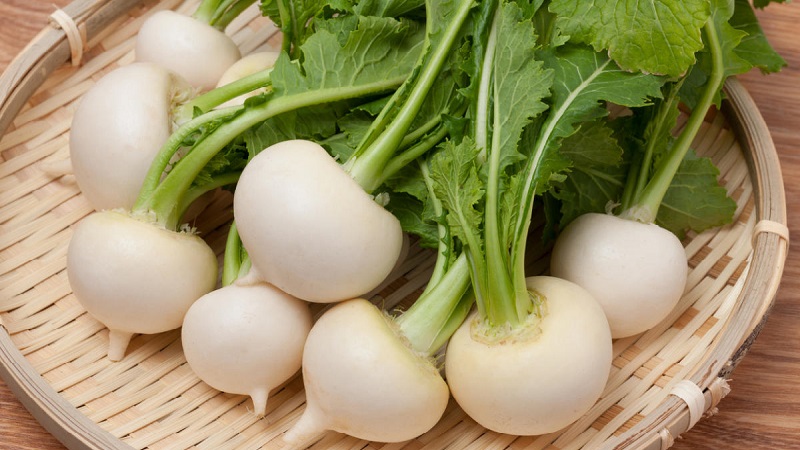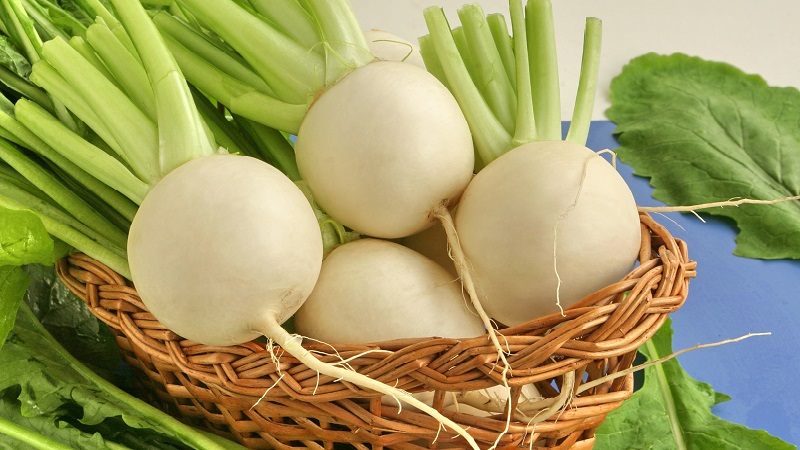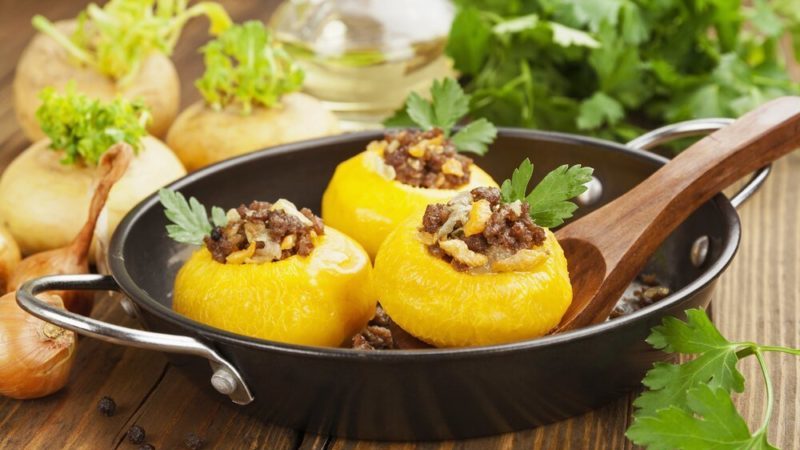What is turnip, what it looks like in the photo, how to cook it and eat it
Turnip was one of the main food products in Russia for many centuries, and now it is undeservedly forgotten. Only rare connoisseurs of a vegetable know its taste and useful properties. It is used not only in cooking, but also in traditional medicine.
The content of the article
What is turnip

It is an edible root vegetable. The turnip belongs to the cruciferous family, the genus cabbage, belongs to the dicotyledonous herbaceous plants. The ancient Greeks and Egyptians began to actively cultivate the vegetable, gradually it won the trust of the farmers of Central and Western Asia. It came to the territory of Russia from Byzantium and until the 16th century remained an indispensable product until it was supplanted by potatoes.
What does a vegetable look like
In the first year of life, turnip forms a root crop, which consists of the lower part of the shoot and the hypocotyl - the part of the stem between the root and the cotyledons. The shape depends on the species, it can be oval, elongated, oblong or flat. The pulp is dense and juicy, the color is usually white or yellow, less often white-purple and white-pink.
On the surface of the turnip, a rosette with long-petiolate serrated leaves is formed. The thickened stem reaches an average of 40-50 cm in height.
In the second year, flower shoots 3-8 cm long and seeds are formed. Inflorescences are corymbose. Turnip flowers of yellow shades bloom from the periphery to the center. Root crops are tied in the form of a brush from erect pods with small spherical seeds.

What colors are there
The shade of the root crop depends on the content of plant pigments:
- Black turnip contains many herbal antibiotics.
- Green turnip tastes like a radish, contains an increased amount of niacin and iron.
- Yellow - turnip is the leader in the amount of carotene, vitamin PP and C.
- White turnip has the most delicate taste, low calorie content.
There are also light red types of turnips, purples and purples.
Perennial or annual plant
Depending on the type of turnip, it can be both annual and perennial.
Turnip types

The classification of types and varieties of turnip is based on:
- the amount of sugar compounds in the composition;
- yield;
- ripening period.
Sweet
Sweet turnip varieties contain very little bitter essential oils, which gives root vegetables a delicate, spicy flavor. Popular among them:
- Snow White - early ripe, weighing 50-80 g, with high agricultural technology reaches 200 g. The root crop is white with a thin skin, the pulp is juicy and crispy.
- Golden ball - mid-early turnip rich in vitamins. Weight reaches 400 g, yellow inside and outside, rounded shape.
- White ball is a fruitful mid-season variety. Average weight - 500 g, taste without bitterness. Young leaves are suitable for human consumption.
- Dunyasha is a turnip weighing 150-200 g, with an orange peel and golden yellow flesh.
The most productive
Varieties with increased yields give from 1 sq. m 4 kg or more. They have proven themselves in practice:
- Petrovskaya-1. Grown for several decades, ideal for central Russia. An unpretentious and hardy variety, ripens in 60-65 days. Root crops of 60-150 g lie for a long time and do not lose their beneficial properties.
- Tokyo - salad variety, harvested 27-30 days after sowing. Both small-sized turnips and foliage are eaten. The variety is resistant to cold weather, but requires constant watering.
- Snow Maiden is an early culture with an average weight of 65 g. In the open field it gives 3-3.5 kg per 1 sq. M. m, indoor - up to 8 kg.Shade-tolerant, moisture-loving, resistant to flowering.
With large roots
The varieties are distinguished by the most voluminous and strong root crops with an increased period storage. Among them are:
- White Night is a Czech variety. The root vegetable weighs from 500 g. The pulp is juicy, not bitter, with excellent keeping quality.
- Milan. Ripens in 50-60 days, looks like a radish, weighs 100-200 g. Taste quality is high, resistant to diseases.
- Russian size. Weight reaches 2 kg, does not deteriorate during transportation, it is stored all winter without loss of quality. Fleshy root vegetable with traditional taste.
Early

Early maturity is one of the key factors in the popularity of turnips. This category includes varieties, the growing season and ripening of which is 45-60 days:
- Glasha is a flat-round turnip, weighing 80-100 g. Sweet taste, universal use, medium keeping quality.
- Geisha is a fruitful variety for salad purposes. Root crops weighing 60-200 g, foliage is used as greens. Relatively resistant to disease, not suitable for storage.
- May yellow ripens in 60-70 days, depending on weather conditions. In a favorable climate, it can gain weight up to 1.2 kg.
Mid-season
Varieties with an average growing season of up to 90 days are in no less demand. Most productive:
- Luna is a cold-resistant crop for fresh consumption and culinary processing. Average weight - 150-200 g. Shows a stable yield up to 1.5 kg per 1 sq. M. m.
- Gribovskaya. After 70-75 days, a large turnip of light purple color ripens. Suitable for winter storage, cold-resistant.
- Nurse - yellow roots of 200-250 g. Taste quality is above average, universal purpose. Productivity - up to 4.2 kg per 1 sq. m.
Late
If the turnip ripens after 90 days or more, it is considered late. Popular among gardeners:
- Comet is a fruitful variety with excellent taste characteristics. The standard weight of a vegetable is 150-200 g, the shape is elongated, on the top there is a purple color.
- Orbit. Harvested 3 months after planting. Turnip weight often reaches 500 g, suitable for storage.
- We pull-pull. The variety is valued for its low bitter content and high amount of vitamins and minerals. The mass of the root crop usually does not exceed 200 g.
How to cook and eat turnips
The vegetable is rich in vitamins and biologically active substances.
Important! Turnips contain a rare compound called glucoraphanin, which prevents the formation of cancer cells.
Beneficial features:
- has anti-inflammatory and bactericidal action;
- accelerates metabolic processes;
- strengthens the immune system, bone tissue and nervous system;
- maintains the elasticity of blood vessels.
Cases when a vegetable is contraindicated:
- gastrointestinal diseases, diabetes;
- severe pathologies of the kidneys and liver;
- endocrine system disorders.
Root vegetables are eaten raw, pickled or thermally processed. Leafy varieties are used only fresh.
Raw
An adult is allowed to eat 200-300 g of raw turnips per day. It is ground on a grater or finely chopped for making savory salads, side dishes for meat and fish. The leaves are added to soups and sauces.
Important! In dietetics, turnips are gaining popularity due to their high content of cellulose and fiber. They help to correct weight in a short period of time.
Cooking recipes

Eating a steamed or boiled vegetable can help prevent digestive problems.
Steamed
Steamed turnip is the simplest dish. Serve it as a side dish. The dish is irreplaceable in the post.
You will need:
- turnips - 1-2 pcs. per person;
- water - 2 tbsp. l .;
- salt.
Preparation:
- Turnips are washed and peeled.
- Cut into thin slices and lay out in a mold.
- Add water, salt and place in the oven at 160-180 ° C.
- An hour later, serve hot, after adding a little butter.
Porridge
Porridge comes with sugar, spicy or with vegetables. For turnips with rice, it is advisable to choose a sweet variety.
Ingredients:
- rice - 120 g;
- turnip - 350-400 g;
- milk - 350 ml;
- butter;
- salt and sugar to taste.
Preparation:
- Finely chopped root vegetable is stewed with butter for 10 minutes.
- Crushed to a puree state.
- Transfer to a saucepan with a thick bottom, add washed rice, milk and cook until cereal is cooked.
The hot porridge is seasoned with sugar and butter.
Fried
Fried turnips are served as a side dish or as an independent dish.
Ingredients:
- turnip - 1 kg;
- butter - 20 g;
- vegetable oil - 150 ml;
- onions - 1 large head;
- salt pepper.
Preparation:
- The vegetable is cut into strips and boiled for 3 minutes.
- Strain and put in a frying pan preheated with oil.
- After 5 minutes add onion, salt, spices and fry for another 10 minutes until tender.
If desired, season with sour cream, sprinkle with chopped herbs.
Conclusion
Turnip has a lot of useful properties and does not lose its relevance with the modern variety of vegetables. The many flavors and shades of the root vegetable make it an ideal find for culinary experiments. Gardeners value turnips for their unpretentiousness, a wide selection of varieties and quick ripening.